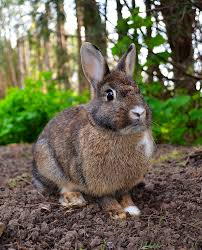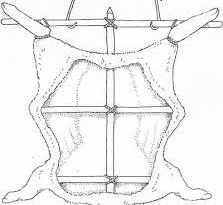Introduction and Characteristics of Rabbits
Rabbit are used for meat, for vocational projects, as laboratory animals, as teaching tool, as animal research models and for pets. Because of their use in a wide range of enterprises, it is necessary to have a good knowledge of the different aspect of their management and nutrition.
A rabbit is a swift moving small herbivorous mammal, with big ears, large muscular hindlegs, large front teeth and a short tale. Their powerful hindlegs are built for running, jumping, and digging out burrows.
They have an excellent sense of smell, hearing, and eyesight. But their eyesight at night is actually worse than a human’s. This is because they are crepuscular, chiefly active at twilight, the time between day and night. Rabbits vary in size from one to two feet (30 to 60 cm) long.
Often people include hares in the term rabbit but these are two different genera. The main differences are, that hares have longer ears, bigger feet, do not live in burrows, and give birth to young that are not blind and naked from birth (precocial).
Taxonomy of Rabbits
The rabbit belongs to the Phylum: Chordate
Sub-phylum: Vertebrata
Class: Mammalia
Order: legomorpha
Family: Leporidae
Genus: Oryctolagus
Specie: Oryctolagus cuniculus
The domestic rabbit descended from wild rabbit found in the Mediterranean countries and was introduced into England in the late 11th and early 12th century. The different breeds of modern domestic rabbit have evolved as far back as the 18th century.
Advantages of Rabbit Keeping

Rabbit can be quickly grown.
They are a cheap source of protein. China, on the other hand, is the world’s leader in rabbit meat production with 31%.
They can be reared for consumption or commercial undertaking.
In the United States rabbits are raised mainly for nonfood purposes such as pets, medical and cosmetic research, and some high-quality rabbit skins. Rabbits are altricial, which means their young are born blind and naked, and require parental care.
In the wild, a rabbit will live about a year. In comparison, a well-cared for house rabbits are expected to live 8 to 12 years in Europe and Asia.
Read Also : How to Care for Newly Weaned Rabbits Properly
The meat of rabbit is fine grained white meat, which is high in protein, low in fat. The World Health Organization has recognized rabbit meat as the leanest and healthiest meat in the world.
Rabbit meat is low in cholesterol.
Rabbits are territorial but live in a loosely organized society.
A rabbit carcass is only 20% bone and its meat can be easily substituted for poultry in many recipes. In fact, the lack of fat in rabbit meat is what leads to a condition called “rabbit starvation.”
This condition occurs because the simplest way for your body to generate energy is to convert carbohydrates into glucose. But if carbohydrates are not available to your body, it can convert fat into glucose; if fat is not available, it can convert protein into glucose.
This process is called gluconeogenesis, and it takes place in the liver. Today’s high fat diet now welcomes the same lean qualities that were lethal to our ancestors.
Biology of the Domestic Rabbit
Rabbits have large eyes located on the upper part of the sides of their head that have a 360o field of view, except for a blind spot at the tip of their nose. Their eyes are limited in terms of depth perception and close- up vision.
Instead, the rabbit’s vision system is designed to pick up any kind of movement at a far distance. Rabbits are crepuscular, meaning they are most active at dawn and dusk.
This is part of their survival strategy since at twilight it is too bright for the nocturnal predators to see well, and too dark for the diurnal predators.
They may also be active at night and during the day, but bright light restricts the aperture of the pupils, decreasing visual acuity. Intense light can actually blind a rabbit.
Their eyes are composed of a double retinal system of rods and cones that are especially sensitive to the blues and greens present at twilight.
Rabbits have a third eyelid called a nictitating membrane. It moves across the surface of the eye, offering protection and lubrication.
As with other herbivores, rabbits spend a great deal of time either feeding in the open or re-ingesting caecal pellets under safe cover. Rabbits will usually graze close to their burrow.
Their teeth grow continuously, as they are “open rooted”. The modified incisors act like a chisel cutting instrument, clipping off vegetation before it is passed to the back of the mouth for grinding. Their teeth grow at a rate of 3.9 to 4.7 inches (10 to 12 cm) per year.
The anterior side (the side you see) of the incisors has a layer of enamel which causes it to wear more slowly than the posterior side, which has no enamel. During the course of wear this forms a natural chisel profile, keeping the teeth sharp.
The lower teeth grow faster than the upper teeth. As they feed, they drop fecal pellets which fertilize the plants they eat. Rabbits are territorial but live in a loosely organized society.
The female hierarchy within the warren is separate from the male hierarchy. While fighting is used to establish the hierarchy’s order, it is rare in an established colony. Exceptions to this rule are fights over receptive females, and empty burrows.
Rabbit behaviour is not flamboyant and overt, but quiet and heavily reliant on scent. They are born with this sense of smell and it allows them to find their mother’s nipples so they can feed. 100 million sent cells form a nasal membrane with movable folds that assist in the detection of scent.
They twitch their nose up and down to help identify a scent. This is called “nose blinking.” They use this highly developed sense of smell to identify predators and other rabbits.
Rabbits mark their territory with droppings that are given an individual scent from glands in the anus. They also use scent glands under the chin, either side of the perineum (inguinal glands,) and at the anus (anal glands) to demonstrate ownership of property such as burrow entrances.
Inguinal glands are large pouch-like glands that usually contain a yellow/brown oily deposit. Does are often more territorial than bucks, and can get aggressive towards other rabbits that enter their territory.
Above ground sentry rabbits will sit upright on their haunches, allowing them to see further. When a possible predator threatens, the sentry rabbits will thump the ground loudly with his hind legs.
When the other rabbits out in the open hear the warning, they will either flatten themselves on the ground and hide, or run for cover or the safety of the burrow.
On occasion, in defense of their burrow or nest, rabbits have been known to fight tooth and nail. Both bucks and does will kick, bite, and spray urine as a defensive gesture when threatened.
A rabbit running from a predator will only run in a straight line for a short distance before bouncing to the side. When pursued for longer distances, rabbits will run in wide circles.
The desert cottontail, for instance, will run in a circle that is approximately an acre in size. As a rabbit runs, it emits scent from between its toes. The scent becomes weaker as the rabbit tires, which can actually be sensed by some well-trained hunting dogs.
Pregnant females have very little scent as a form of natural protection from predators. A good time to look for rabbits is on the first warm day after a cold snap. They often will be sitting out in the open, soaking up the sunlight.
On cold and windy days, they will either be in their burrows or in thick tangles of vines, briars, and any other cover that protects the rabbit from the elements.
Feed Digestion in Rabbits
Rabbits are hind-gut fermenters, designed to digest low quality, high fiber food such as grass. Unlike other fermenters, rabbits have a high rate of flow through their digestive tract.
This minimizes the need to store and carry food that is being processed, and results in a small, lightweight, and fast moving animal. But their digestive system is also highly efficient, discarding large particles and collecting small particles for fermentation and nutrient extraction.
This efficiency minimizes the time that rabbits must spend above ground exposed to danger while feeding. Rabbits will eat almost any vegetation they find, including leaves, shoots, herbs, grasses, grains, leaf buds, bark, stems, branches, and vegetables such as lettuce, beets, carrots, and of course cabbage.
North American rabbits do not dig burrows as European rabbits do. Instead, they have shallow fur-lined nests on the surface of the ground called “forms”.
These rabbit forms are well concealed in dense vegetation. European wild rabbits, on the other hand, live in a series of underground tunnels called a warren.
In summary, there are a lot of advantages in raising rabbits (Oryctolagus cuniculus). Because of their small size they also fit into the farming system common to the tropics. The meat of rabbits is healthy with very low cholesterol compared to chicken. The rabbit being a hindgut fermenter can digest fibrous feed materials but for high productivity some form of supplementation is necessary.
In this article also you have learnt about the origin of the domestic rabbit, the advantages of raising rabbits as well as the high quality of rabbit meat. The biological characteristics of rabbits have also been highlighted. The article also describes the digestion process in rabbits with its peculiarity.
Read Also : Ways to Generate Money from Bulky wastes










Wow! This can be one particular of the most helpful blogs We have ever arrive across on this subject. Basically Excellent. I am also an expert in this topic so I can understand your effort.
Thank you so much and we are glad that you find our article very helpful